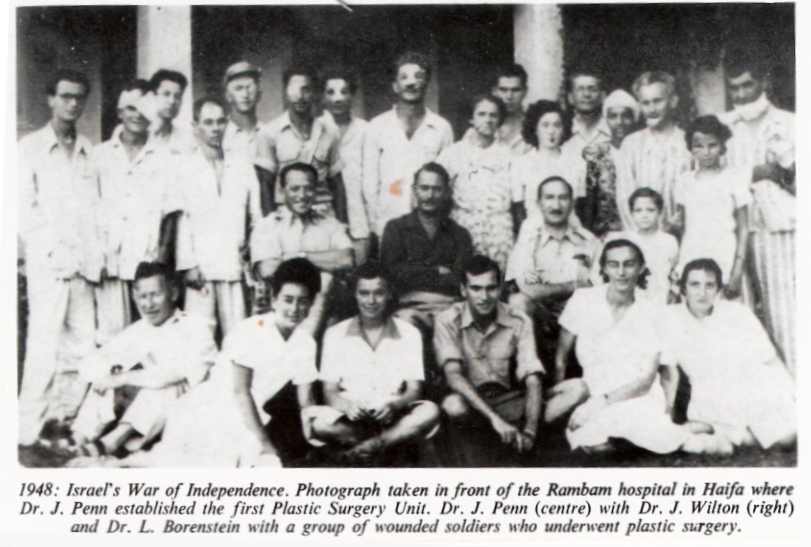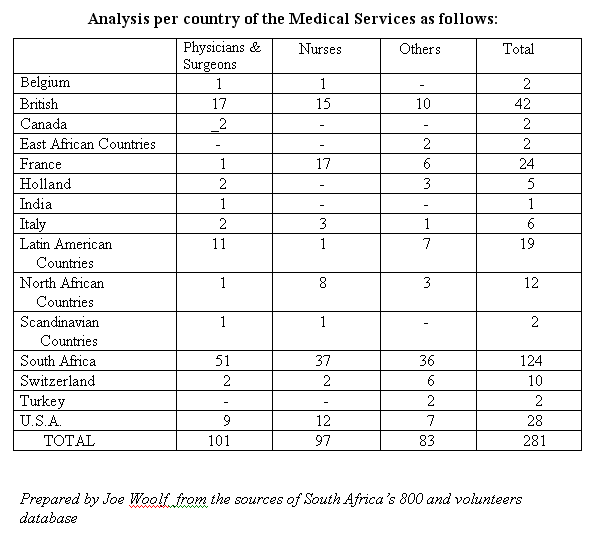
The first known overseas volunteer surgeon was Doctor Leo A. Bornstein of Jersey City, N.J., an experienced US Army battlefield surgeon. He commanded Military Hospital No. 2 in Galilee before the State was established, and later served as Chief Surgeon at Military Hospital No.10. On March 15th 1948, he wrote to his family in the USA from the Northern Galilee, as follows:
“It is a great strain on our manpower to have the same men who plough the fields fight the battles … no previous army experience compares with this. The only comparisons I can make is with the first settlers in America who were continually attacked by Indians, supplied with guns by the French. However in those days a wooden fence was security enough, now we have to protect ourselves against the most modern British guns.”
“The British Command has just informed us that because of the barbarous act of defending ourselves we shall be under complete curfew for seven days. This curfew applies to the whole Galilee and, of course, it pertains to the Jews only – another aid to the Arabs since they will be able to transport their arms without any hindrance on our part. The Command informed us that they will be carrying “Goods” in British vehicles to the Arab villages and if one of these vehicles is mined or fired upon, we shall be held responsible and the curfew will be extended for a longer period. Of course, our running short of goods does not matter.”
“Our supplies are very meager, if you saw the conditions under which I have to operate, you would be absolutely shocked. They are as primitive as can be. I continually say that I shall go to Tel Aviv and demand more help, and if they tell me that they cannot supply it, I shall not return. But in my heart I know I shall not desert these boys even if I have to use canvas as bandages, nails as needles and a hammer as an anesthetic. I feel proud to be one of them and I only hope that God gives me the courage and strength to hold out and not collapse under the strain. This army of ours is without uniform, without arms, and without medals, but in spite of all the discomforts and dangers, I would not change all this for Buckingham Palace in England or any other mansion in the Diaspora.”
A few days after the April 15th massacre of the Mount Scopus medical convey on its way to Hadassah Hospital, South African Dr. Arthur Helfet, carrying with him 200 lb weight of surgical instruments was the first doctor to leave from Palmietfontein. Two friends, Doctors Lionel Meltzer and Jack Penn saw him off. They discussed the somber news of the seventy Jews, the majority doctors and professors, having been ambushed and massacred.
Dr. Helfet was no stranger to the Middle East. During World War II, while serving in the Royal Army Medical Corps, he spent a year as Consultant Orthopedic Surgeon to the Middle East Forces with Headquarters in Cairo.
The chartered Dakota in which Dr. Helfet left would take four days to reach Lydda, avoiding Egypt, but it did not work out that way. En route it was learned that the Arabs had fired on a TWA Plane near Lydda. This troubled the pilot. Leaving Wadi Halfa for the final leg of the flight, he announced that the plane would land at Cairo “owing to engine trouble.” When the plane landed on the runway, an agitated agent of the Charter Company came aboard and breathlessly advised all passengers to say, when questioned about their religion, “Church of England.”
Dr. Helfet gave his religion as ‘Reform’. The two officers looked at each other, shrugged their shoulders and signed his temporary visa.
The Dakota remained in Cairo for three days before leaving, ostensibly for London, but landed a little later at Lydda, where Dr. Helfet was met by Dr. Chaim Sheba, head of the shadow Army Medical Services. That night at a meeting of all civilian and Haganah sections of the Yishuv he was appointed Consultant Orthopedic Surgeon, that after May 14th changed to an official appointment to all of the Medical Services in Israel. During his first few weeks, the Cape Town doctor visited and examined all Haganah, Irgun and civilian wounded in the Tel Aviv area. Dr. Sheba meantime was searching for beds, basic medical and surgical supplies including kitchen equipment, to equip all the surgical units being formed. A windfall came by way of the Chairman of the Potash Works on the Dead Sea, who allowed the doctors to take over equipment just arrived for a projected convalescent home.
On the day after its capture on April 22, Dr. Helfet was directed to a small Arab hospital in Haifa. An enormous poster of the Mufti of Jerusalem dominated the main hall. On the patients’ beds were horrible Arab propaganda leaflets showing the tortures which it suggested the Jewish forces were likely to inflict on the captured, which explains a lot about the Arab flight and subsequent refugee problem.
In May, Dr. Helfet became attached to Yigal Alon’s Palmach Headquarters at Rosh Pina and also to the new 25-bed hospital at Kfar Giladi in the Northern Galilee. With Alon at that time was the American Colonel Mickey Marcus, who was serving as military adviser to the Haganah and the Palmach. The Palmach’s victories at Safed and Canaan had been relatively light, but Nebi Yusha cost the lives of 28 Palmachniks. “The excessive exuberance of the young Palmachniks trying out captured American-made cars gave us more casualties at that time than the battles”, Dr. Helfet later remarked.
Dr. Helfet prepared a comprehensive report for Dr. Sheba concerning preparations in the event the war would last more than six weeks. In the plan to implement these requirements, he was sent to London on May 28th to enlist the aid of Jewish doctors there.
As a result, Dr. I.C. Michaelson, a leading orthopedic surgeon, Dr. E. Kaplan, a Hebrew-speaking psychiatrist and Dr. Cyril Kaplan, a South African completing his orthopedic training at the time, and several general practitioners were soon on their way to Israel with £25,000 worth of medical and surgical equipment.
Dr. Helfet then left to continue his mission in South Africa. As a result, on June 25th an advance guard of South African doctors and other medical personnel flew into Haifa. This group included Dr. Lionel Meltzer who was soon to be appointed second in command to the illustrious Dr. Sheba of the Military Medical Services, Dr. Louis Miller, Army Psychiatrist, Dr. Jack Wilton, General Surgeon, Saul Theodore Elion, a chemist, Zelda Ravid, a nursing sister, who motivated by a great desire to volunteer for services, left her two very young children (aged 4 and 1) in the care of her mother.
In July and August, they were joined by Dr. Harry Berelowitz, anesthetist from Cape Town, another Capetonian Dr. Victor Resnikov, a Radiologist, Dr. Gerald Landsman and Dr. Ellis Rosenberg, and within a few months there were twenty three doctors from South Africa. By the end of the war there were fifty-one in Israel, thirty-seven nurses, the majority qualified nursing sisters, twenty one other medical professionals and fifteen combat and hospital medics, one of whom “Locky” Fainman, was to be cited for bravery for treating wounded under fire. Another, Gideon Rosenberg, was killed fighting in the Jerusalem hills.
Another early arrival was Dr. Joseph Katz from Denmark, on the ship ‘Transylvania’ , May 1st with many other volunteers among the refugee passengers. He had served as medical officer in the 9th Brigade (ODED).
Two medical officers were killed in action: British Dr. Isaiah Morris was killed in the heavy battles a Sejera (Ilaniya) on June 11th. He was Medical Officer to the Golani Brigade. A mortar shell hit his advance aid post while treating wounded. The same shell that killed Morris also severely wounded Swiss volunteer Medical officer Dr. Max Goldberg. Goldberg had arrived with his nursing sister wife, Hilde, who was also part of the Golani Medical
team. Hilde, a pediatric nurse, had survived in the Dutch Underground during the Nazi occupation. After the war she was mobilized to care for child survivors of the Bergen Belsen Concentration Camp. There she met Dr. Max Goldberg, sent there by the Jewish Agency from Switzerland, as a doctor. In 1948 they volunteered for Machal as a husband and wife medical team.
During World War 11, Dr. Isaiah Morris had served as a Medical officer of the Suffolk Regiment. Towards the end of the war, during the heavy battles crossing the Rhine River, he had been decorated with the Military Cross (MC) for bravery in treating wounded under fire. Before he left London for the Marseilles Haganah Camp, he was specializing as a pediatrician.
In February 1948, he sailed on the Aliyah Bet ship “Medinat Israel” as its Medical officer. The ship was intercepted by the Royal Navy, and the crew and refugees interned in the British camps at Cyprus. After a short while he was released and reached Israel late March, becoming Golani’s Chief Medical Officer.
Dr. Solomon Morli-Dahan, a volunteer from Spanish-Morocco, served in a Druse-Circassian Minorities Unit. On October 28th he was killed in a clash that was a prelude to the Hiram Operation which started on the 29th. He had gone to the aid of a wounded soldier under fire. Most, if not all field combat units had Machal medical officers who were also serving at field hospitals at Gedera and Ruhama in the Negev.
All the large military hospitals were staffed by Machal surgeons, physicians, nurses and other specialist medical professionals. Their services saved thousands of lives.


